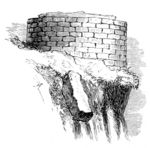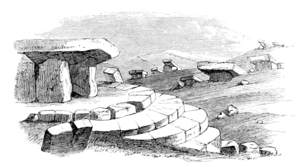of greater or less dimensions, so arranged as to form a series of steps. Sometimes, indeed, there are only two outer circles, and occasionally only one. The diameter of the larger axis of that here represented is about 30 feet. In the centre are usually found three long and slender upright stones, forming three sides of a long rectangle, and the interior is paved with pebbles and broken stones.
"The Chouchas are found in the neighbourhood of the Bazinas, and are closely allied to them. They consist of courses of stones regularly built up like a wall, and not in steps like the Bazinas. Their diameter varies from 7 to as much as 40 feet; but the height of the highest above the soil does not exceed 5 to 10 feet. They are usually capped and covered by a large flag-stone, about 4 inches thick, under which is a regular trough or pit formed of stones from a foot and a half to 3 feet in thickness. The interior of these little towers is paved like the Bazinas; and indeed M. Payen considers that they are the equivalents in the mountains of the Bazinas in the plains."[1]
In many instances the chouchas and bazinas are found combined in one monument, and sometimes a regular dolmen is mounted on steps similar to those of a bazina, as shown in the annexed woodcut, representing one existing halfway between Constantine
- ↑ Flower, in Norwich volume, pp. 201 et seqq.


